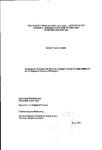THE TURKEY-WING MUSSEL, Arca zebra : ASPECTS OF ITS ECOLOGY, REPRODUCTION AND PHYSIOLOGY IN BERMUDAN WATERS
| dc.contributor.author | Sarkis, Samia Christiane | |
| dc.contributor.other | School of Biological and Marine Sciences | en_US |
| dc.date.accessioned | 2013-11-14T10:01:42Z | |
| dc.date.available | 2013-11-14T10:01:42Z | |
| dc.date.issued | 1992 | |
| dc.identifier | NOT AVAILABLE | en_US |
| dc.identifier.uri | http://hdl.handle.net/10026.1/2701 | |
| dc.description.abstract |
Growth and reproductive potential of the turkey-wing mussel in Bermuda was assessed following field studies, the determination of nutrient storage sites and nutrient use during periods of reproduction, and seasonal fluctuations in the scope for growth index. Larval and post-larval development were also described and were typical of the family Arcidae. Furthermore, post-larval production, by controlled laboratory rearing, was suggested as a useful tool for enhancement of stocks for this species. Both preliminary field and laboratory studies indicated slow shell growth of the species throughout its life cycle. Temperature minima recorded during the winter months were suggested to have a negative effect on growth of Area zebra in the field. Gonadal development, expressed as gonadic index (dry gonad weight/empty shell weight x100) and confirmed by histological analyses, indicated a "rest" period during the winter months. The reproductive cycle was assessed and two well-defined spawning seasons, early summer (June) and autumn (September), were determined. The metabolic processes occurring prior to the summer spawning period were regulated by a glycogen-based metabolism with the pedal muscle as main storage organ. Processes regulating the second reproductive activity are characterized by a direct reliance on ingested food, favoured by high environmental temperature and food supply. Calorific values pointed to a low storage of nutrient. The adaptability of the turkey-wing mussel to low food supply was demonstrated by its response to laboratory-induced starvation, expressed as the molar ratio of oxygen consumed to ammonia excretion (O/N). Temperature played a significant role in the responses of the physiological variables in scope for growth (SFG) affecting most crucially clearance rate, hence energy inake. The inherently high growth efficiency (K2) determined for A. zebra in Bermuda, and determination of temperature as the key causal agent of its scope for growth, suggests the limitation of the Bermuda environment to the growth and reproduction of the species. | en_US |
| dc.description.sponsorship | Bermuda Biological Station for Research Inc. and Plymouth Marine Laboratory | en_US |
| dc.language.iso | en | en_US |
| dc.publisher | University of Plymouth | en_US |
| dc.title | THE TURKEY-WING MUSSEL, Arca zebra : ASPECTS OF ITS ECOLOGY, REPRODUCTION AND PHYSIOLOGY IN BERMUDAN WATERS | en_US |
| dc.type | Thesis | |
| plymouth.version | Full version | en_US |
| dc.identifier.doi | http://dx.doi.org/10.24382/3677 | |
| dc.identifier.doi | http://dx.doi.org/10.24382/3677 |
Files in this item
This item appears in the following Collection(s)
-
01 Research Theses Main Collection
Research Theses Main


